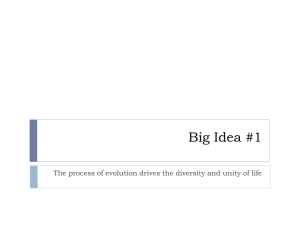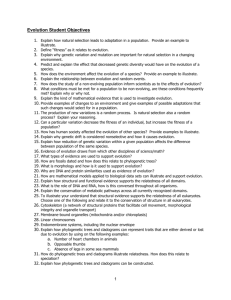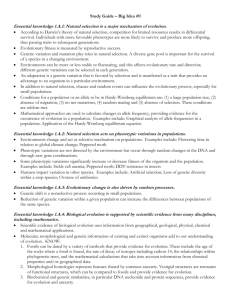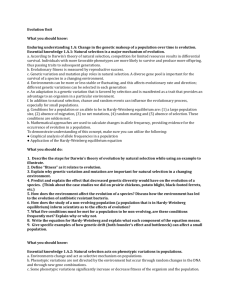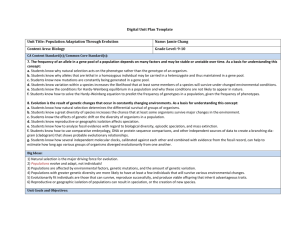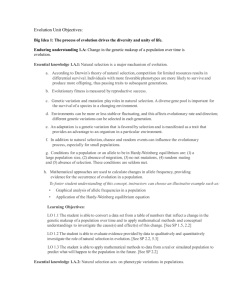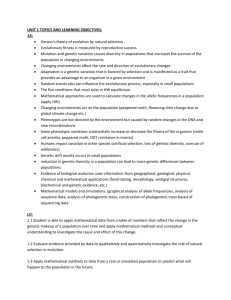Unit 5 Preview & Overview – Evolution
advertisement
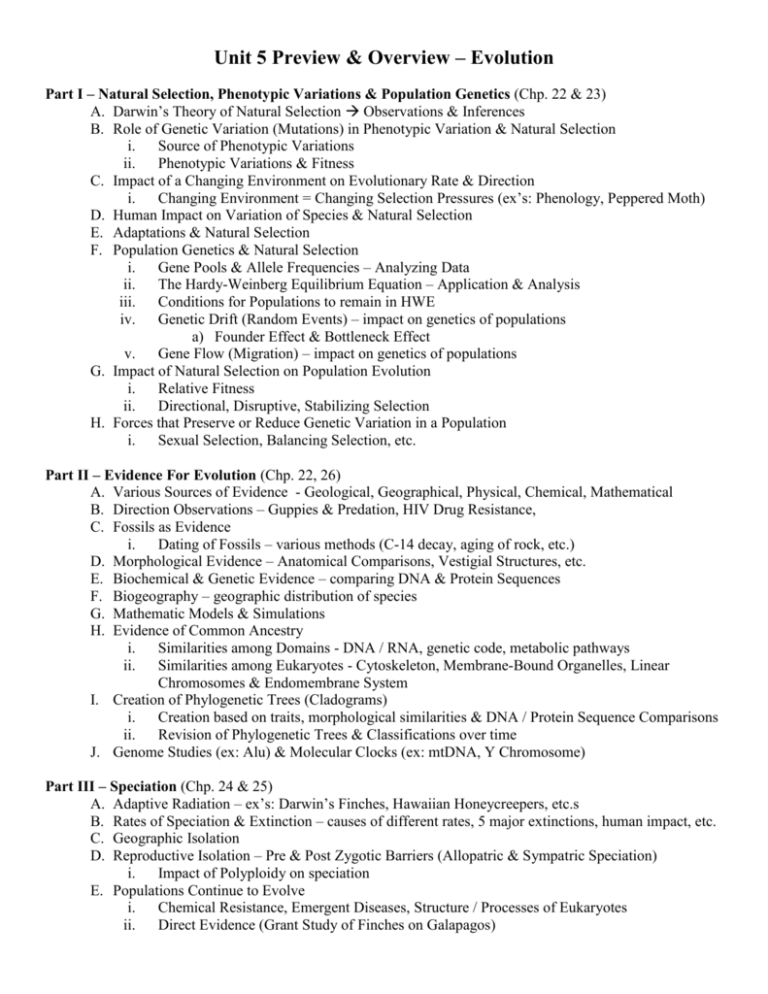
Unit 5 Preview & Overview – Evolution Part I – Natural Selection, Phenotypic Variations & Population Genetics (Chp. 22 & 23) A. Darwin’s Theory of Natural Selection Observations & Inferences B. Role of Genetic Variation (Mutations) in Phenotypic Variation & Natural Selection i. Source of Phenotypic Variations ii. Phenotypic Variations & Fitness C. Impact of a Changing Environment on Evolutionary Rate & Direction i. Changing Environment = Changing Selection Pressures (ex’s: Phenology, Peppered Moth) D. Human Impact on Variation of Species & Natural Selection E. Adaptations & Natural Selection F. Population Genetics & Natural Selection i. Gene Pools & Allele Frequencies – Analyzing Data ii. The Hardy-Weinberg Equilibrium Equation – Application & Analysis iii. Conditions for Populations to remain in HWE iv. Genetic Drift (Random Events) – impact on genetics of populations a) Founder Effect & Bottleneck Effect v. Gene Flow (Migration) – impact on genetics of populations G. Impact of Natural Selection on Population Evolution i. Relative Fitness ii. Directional, Disruptive, Stabilizing Selection H. Forces that Preserve or Reduce Genetic Variation in a Population i. Sexual Selection, Balancing Selection, etc. Part II – Evidence For Evolution (Chp. 22, 26) A. Various Sources of Evidence - Geological, Geographical, Physical, Chemical, Mathematical B. Direction Observations – Guppies & Predation, HIV Drug Resistance, C. Fossils as Evidence i. Dating of Fossils – various methods (C-14 decay, aging of rock, etc.) D. Morphological Evidence – Anatomical Comparisons, Vestigial Structures, etc. E. Biochemical & Genetic Evidence – comparing DNA & Protein Sequences F. Biogeography – geographic distribution of species G. Mathematic Models & Simulations H. Evidence of Common Ancestry i. Similarities among Domains - DNA / RNA, genetic code, metabolic pathways ii. Similarities among Eukaryotes - Cytoskeleton, Membrane-Bound Organelles, Linear Chromosomes & Endomembrane System I. Creation of Phylogenetic Trees (Cladograms) i. Creation based on traits, morphological similarities & DNA / Protein Sequence Comparisons ii. Revision of Phylogenetic Trees & Classifications over time J. Genome Studies (ex: Alu) & Molecular Clocks (ex: mtDNA, Y Chromosome) Part III – Speciation (Chp. 24 & 25) A. Adaptive Radiation – ex’s: Darwin’s Finches, Hawaiian Honeycreepers, etc.s B. Rates of Speciation & Extinction – causes of different rates, 5 major extinctions, human impact, etc. C. Geographic Isolation D. Reproductive Isolation – Pre & Post Zygotic Barriers (Allopatric & Sympatric Speciation) i. Impact of Polyploidy on speciation E. Populations Continue to Evolve i. Chemical Resistance, Emergent Diseases, Structure / Processes of Eukaryotes ii. Direct Evidence (Grant Study of Finches on Galapagos) Calculation / Math Stuff: - Hardy-Weinberg Equilibrium Problems (including Chi-Square Analysis) - Graphing of allele & genotype frequencies / Analysis - Analysis of Evolutionary Evidence Database (DNA & AA sequences, etc.) - Cladograms / Phylogenetic Tree creation from data / Analysis Textbook Chapters: * Chapter 22 (22.2 & 22.3) – Decent with Modification: A Darwinian View of Life * Chapter 23 (22.1, 22.2, 22.3 & 22.4) – The Evolution of Populations * Chapter 24 (24.1, 24.2 & 24.4) – Origin of Species * Chapter 25 (25.2, 25.4 25.5 & 25.6) - History of Life on Earth * Chapter 26 (26.1, 26.2, 26.3, 26.4, 26.5 & 26.6) - Phylogeny and the Tree of Life Learning Objectives 1.1 – 1.26 (review 1.27 – 1.32) Essential Knowledges: 1.A.1, 1.A.2, 1.A.3, 1.A.4, 1.B.1, 1.B.2, 1.C.1, 1.C.2, 1.C.3 (will review 1.D.1 & 1.D.2) I. Big Idea 1 – The process of evolution drives the diversity and unity of life A. Enduring Understanding 1.A: Change in the genetic makeup of a population over time is evolution 1.Essential knowledge 1.A.1: Natural selection is a major mechanism of evolution. a. According to Darwin’s theory of natural selection, competition for limited resources results in differential survival. Individuals with more favorable phenotypes are more likely to survive and produce more offspring, thus passing traits to subsequent generations. b. Evolutionary fitness is measured by reproductive success. c. Genetic variation and mutation play roles in natural selection. A diverse gene pool is important for the survival of a species in a changing environment. d. Environments can be more or less stable or fluctuating, and this affects evolutionary rate and direction; different genetic variations can be selected in each generation. e. An adaptation is a genetic variation that is favored by selection and is manifested as a trait that provides an advantage to an organism in a particular environment. f. In addition to natural selection, chance and random events can influence the evolutionary process, especially for small populations. g. Conditions for a population or an allele to be in Hardy-Weinberg equilibrium are: (1) a large population size, (2) absence of migration, (3) no net mutations, (4) random mating and (5) absence of selection. These conditions are seldom met. h. Mathematical approaches are used to calculate changes in allele frequency, providing evidence for the occurrence of evolution in a population. * To foster student understanding of this concept, instructors can choose an illustrative example such as: • Graphical analysis of allele frequencies in a population • Application of the Hardy-Weinberg equilibrium equation 2. Essential Knowledge 1.A.2: Natural Selection acts on phenotypic variations in populations. a. Environments change and act as selective mechanism on populations. * To foster student understanding of this concept, instructors can choose an illustrative example such as: • Flowering time in relation to global climate change • Peppered moth b. Phenotypic variations are not directed by the environment but occur through random changes in the DNA and through new gene combinations. c. Some phenotypic variations significantly increase or decrease fitness of the organism and the population. * To foster student understanding of this concept, instructors can choose an illustrative example such as: • Sickle cell anemia • Peppered moth • DDT resistance in insects d. Humans impact variation in other species. * To foster student understanding of this concept, instructors can choose an illustrative example such as: • Artificial selection • Loss of genetic diversity within a crop species • Overuse of antibiotics 3. Essential knowledge 1.A.3: Evolutionary change is also driven by random processes. a. Genetic drift is a nonselective process occurring in small populations. b. Reduction of genetic variation within a given population can increase the differences‘ between populations of the same species. 4. Essential knowledge 1.A.4: Biological evolution is supported by scientific evidence from many disciplines, including mathematics. a. Scientific evidence of biological evolution uses information from geographical, geological, physical, chemical and mathematical applications. b. Molecular, morphological and genetic information of existing and extinct organisms add to our understanding of evolution. * Evidence of student learning is a demonstrated understanding of each of the following: 1. Fossils can be dated by a variety of methods that provide evidence for evolution. These include the age of the rocks where a fossil is found, the rate of decay of isotopes including carbon-14, the relationships within phylogenetic trees, and the mathematical calculations that take into account information from chemical properties and/or geographical data. ✘ The details of these methods are beyond the scope of this course and the AP Exam. 2. Morphological homologies represent features shared by common ancestry. Vestigial structures are remnants of functional structures, which can be compared to fossils and provide evidence for evolution. 3. Biochemical and genetic similarities, in particular DNA nucleotide and protein sequences, provide evidence for evolution and ancestry. 4. Mathematical models and simulations can be used to illustrate and support evolutionary concepts. * To foster student understanding of this concept, instructors can choose an illustrative example such as: • Graphical analyses of allele frequencies in a population • Analysis of sequence data sets • Analysis of phylogenetic trees • Construction of phylogenetic trees based on sequence data B. Enduring Understanding 1.B: Organisms are linked by lines of consent through common ancestry. 1. Essential knowledge 1.B.1: Organisms share many conserved core processes and features that evolved and are widely distributed among organisms today. a. Structural and functional evidence supports the relatedness of all domains * Evidence of student learning is a demonstrated understanding of each of the following: 1. DNA and RNA are carriers of genetic information through transcription, translation and replication. 2. Major features of the genetic code are shared by all modern living systems. 3. Metabolic pathways are conserved across all currently recognized domains. b. Structural evidence supports the relatedness of all eukaryotes. * To foster student understanding of this concept, instructors can choose an illustrative example such as: • Cytoskeleton (a network of structural proteins that facilitate cell movement, morphological integrity and organelle transport) • Membrane-bound organelles (mitochondria and/or chloroplasts) • Linear chromosomes • Endomembrane systems, including the nuclear envelope 2. Essential knowledge 1.B.2: Phylogenetic trees and cladograms are graphical representations (models) of evolutionary history that can be tested. a. Phylogenetic trees and cladograms can represent traits that are either derived or lost due to evolution. * To foster student understanding of this concept, instructors can choose an illustrative example such as: • Number of heart chambers in animals • Opposable thumbs • Absence of legs in some sea mammals b. Phylogenetic trees and cladograms illustrate speciation that has occurred, in that relatedness of any two groups on the tree is shown by how recently two groups had a common ancestor. c. Phylogenetic trees and cladograms can be constructed from morphological similarities of living or fossil species, and from DNA and protein sequence similarities, by employing computer programs that have sophisticated ways of measuring and representing relatedness among organisms. d. Phylogenetic trees and cladograms are dynamic (i.e., phylogenetic trees and cladograms are constantly being revised), based on the biological data used, new mathematical and computational ideas, and current and emerging knowledge. C. Enduring understanding 1.C: Life continues to evolve within a changing environment. 1. Essential knowledge 1.C.1: Speciation and extinction have occurred throughout the Earth’s history. a. Speciation rates can vary, especially when adaptive radiation occurs when new habitats become available. b. Species extinction rates are rapid at times of ecological stress. * To foster student understanding of this concept, instructors can choose an illustrative example such as: • Five major extinctions • Human impact on ecosystems and species extinction rates ✘ The names and dates of these extinctions are beyond the scope of this course and the AP Exam. 2. Essential knowledge 1.C.2: Speciation may occur when two populations become reproductively isolated from each other. a. Speciation results in diversity of life forms. Species can be physically separated by a geographic barrier such as an ocean or a mountain range, or various pre-and post-zygotic mechanisms can maintain reproductive isolation and prevent gene flow. b. New species arise from reproductive isolation over time, which can involve scales of hundreds of thousands or even millions of years, or speciation can occur rapidly through mechanisms such as polyploidy in plants. 3. Essential knowledge 1.C.3: Populations of organisms continue to evolve. a. Scientific evidence supports the idea that evolution has occurred in all species. b. Scientific evidence supports the idea that evolution continues to occur. * To foster student understanding of this concept, instructors can choose an illustrative example such as: • Chemical resistance (mutations for resistance to antibiotics, pesticides, herbicides or chemotherapy drugs occur in the absence of the chemical) • Emergent diseases • Observed directional phenotypic change in a population (Grants’ observations of Darwin’s finches in the Galapagos) • A eukaryotic example that describes evolution of a structure or process such as heart chambers, limbs, the brain and the immune system
